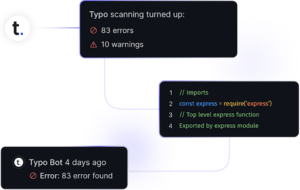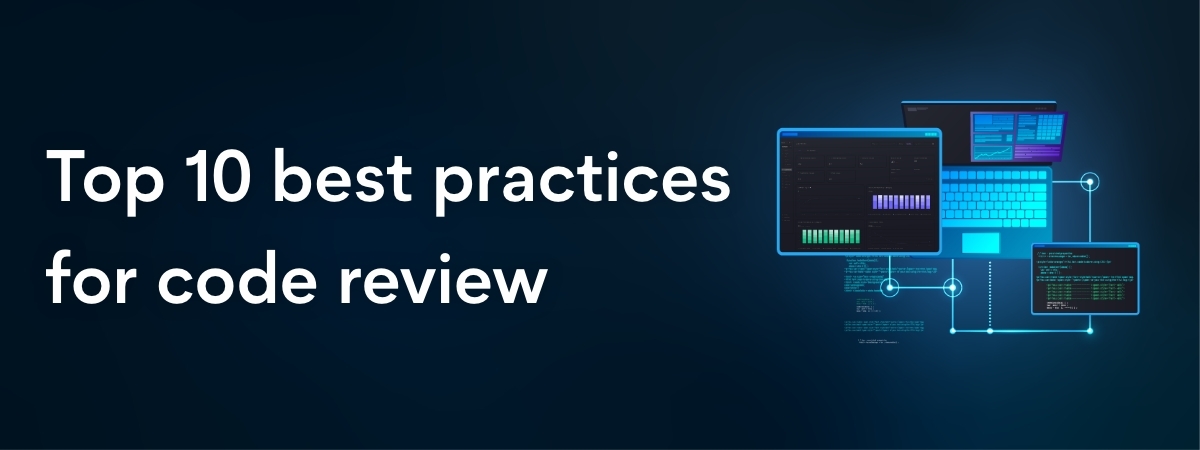Code review is all about improving the code quality. However, it can be a nightmare for engineering managers and developers when not done correctly. They may experience several code review challenges and slow down the entire development process.
Hence, following code review best practices to promote collaboration, improve code readability, and foster a positive team culture is crucial.
Types of code reviews
There are two types of code reviews: 1. Formal code review and 2. Lightweight code review.
Formal code review
As the name suggests, formal code reviews are based on a formal and structured process to find defects in code, specifications, and designs. It follows a set of established guidelines and involves multiple reviewers.
The most popular form of formal code review is Fagan Inspection. It consists of six steps: Planning, overview meeting, preparation, inspection meeting, casual analysis, reworking, and follow-up.
However, the downside of this type is that it is more time-consuming and resource-intensive than other types of code review.
Lightweight code review
Such a type of code review is commonly used by the development team and not testers. It is mostly followed when code review is not life-threatening. In other words, when reviewing a code doesn’t impact the software quality to a great extent.
There are four subtypes of lightweight code review:
Instant code review
This can also be known as pair programming. In this type, two developers work together on the same computer where one is writing code while the other is reviewing it in real time. Such a type is highly interactive and helps in knowledge sharing and spotting bugs.
Synchronous code review
In synchronous code review, the author produces the code themselves and asks the reviewer for feedback immediately when done with coding. The coder and reviewer then discuss and improve the code together. It involves direct communication and helps in keeping the discussion real around the code.
Asynchronous code review
While it is similar to synchronous code review, the only difference is that the code authors and reviewers don’t have to look at the code at the same moment. It is usually an ideal choice among developers because it allows flexibility and is beneficial for developers who work across various time zones.
Team code review
This type works for very specific situations. In this, different roles are assigned to the reviewers. It helps in more in-depth reviews and gives various perspectives. For team code reviews: code review tools, version control systems, and collaboration platforms are used.
Choose the correct code review type based on your team’s strengths and weaknesses as well as the factors unique to your organization.
Code review best practices
Create a code review checklist
Code review checklists include a predetermined set of questions and rules that the team will follow during the code review process. A few of the necessary quality checks include:
- Readability and maintainability: This is the first criterion and cannot be overstated enough.
- Uniform formatting: Whether the code with consistent indentation, spacing, and naming convention easy to understand?
- Testing and quality assurance: Whether it have meticulous testing and quality assurance processes?
- Boundary testing: Are we exploring extreme scenarios and boundary conditions to identify hidden problems?
- Security and performance: Are we ensuring security and performance in our source code?
- Architectural integrity: Whether the code is scalable, sustainable, and has a solid architectural design?
Apart from this, answer three questions in your mind while reviewing the code. It includes:
- Am I able to understand what the code does?
- Is the code functioning how I expect it to?
- Is the code fulfilling the regular requirements?
This allows you to know what to look for in a code review, streamline the code review, and focus on priorities.
Foster a code review culture
The code review process must be an opportunity for growth and knowledge sharing rather than a critique of developers’ abilities.
To have effective code reviews, It is vital to create a culture of collaboration and learning. It includes encouraging pair programming so that developers can learn from each other and less experienced members can learn from their senior leaders.
You can establish code review guidelines that emphasize constructive feedback, respect, and empathy. Ensure that you communicate the goals of the code review and specify the roles and responsibilities of reviewers and authors of the code.
This allows the development team to know the purpose behind code review and take it as a way to improve their coding abilities and skills.
Provide constructive feedback
One of the code review practices is to provide feedback that is specific, honest, and actionable. Constructive feedback is important in building rapport with your software development team.
The feedback should point out the right direction rather than a confusion. It could be in the form of suggestions, highlighting potential issues, or pointing out blind spots.
Make sure that you explain the ‘Why’ behind your feedback so that it reduces the need for follow-ups and gives the necessary context. When writing comments, it should be written clearly and concisely.
This helps in improving the skills of software developers and producing better code which further results in a high-quality codebase.
Aim for small, incremental changes
Instead of focusing on all the changes altogether, focus on a small section to examine all aspects thoroughly. It is advisable to break them into small, manageable chunks to identify potential issues and offer suggestions for improvement.
Focusing on a small section lets reviewers examine all aspects thoroughly (Use a code review checklist). Smaller the PRs, developers can understand code changes in a short amount of time and reviewers can provide more focused and detailed reviews. Each change is given the attention it deserves and easier to adhere to the style guide.
This helps in a deeper understanding of the code’s impact on the overall project.
Incorporate code review goals and capture metrics
According to Goodhart’s law, “When a measure becomes a target, it ceases to be a good measure”.
To measure the effectiveness of code review, have a few tangible goals so that it gives a quantifiable picture of how your code is improving. Have a few metrics in mind to determine the efficiency of your review and analyze the impact of the change in the process.
You can use SMART criteria and start with external metrics to get the bigger picture of how your code quality is increasing. Other than this, below are a few internal key metrics that must be kept in mind:
- Inspection rate: The speed at which code is reviewed.
- Defect rate: It is measured by dividing the number of defects found by the number of hours spent on a code review.
- Defect density: It is measured by dividing the defect count by thousands of lines of code.
Besides this, you can use metrics-driven code review tools to decide in advance the goals and how to measure the effectiveness.
Don’t rush your review
As mentioned above, don’t review the code all at once. Keep these three things in mind:
- Don’t review the code for longer than 60 minutes.
- Limit your review to 200-400 lines of code at once.
- Plan for 3 seconds of review time per line of code.
This is because reviewing the code continuously can drop off the focus and attention to detail. This further makes it less effective and invites burnout.
Hence, conduct code review sessions often and in short sessions. Encourage few breaks in between and set boundaries otherwise, defects may go unnoticed and the purpose of the code review process remains unfulfilled.
Rotate code reviewers regularly
Relying on the same code reviewers consistently is a common challenge that can cause burnout. This can negatively impact the software development process in the long run.
Hence, encourage a rotation approach i.e. different team members can participate in reviewing the code. This brings in various skill sets and experience levels which promotes cross learning and a well-rounded review process. It also provides different points of view to get better solutions and fewer blind spots.
With this approach, team members can be familiar with different parts of the codebase, avoid bias in the review process, and understand each other’s coding styles.
Always document code review decisions
Documenting code review decisions is a great way to understand the overall effectiveness of the code review process. Ensure that you record and track the code review outcome for future reference. It is because this documentation makes it easier for those who may work on the codebase in the future.
It doesn’t matter if the review type is instant or synchronous.
Documentation provides insights into the reasoning behind certain choices, designs, and modifications. It helps in keeping historical records i.e. changes made over time, reasons for those changes, and any lessons learned during the review process. Besides this, it accelerates the onboarding process for new joiners.
As a result, documentation and tracking of the code review decisions encourage the continuous improvement culture within the development team.
Focus on coding standards, not personal preference
Emphasizing coding standards promotes consistency, readability, maintainability, and overall code quality.
Personal preferences vary widely among developers. Hence, by focusing on coding standards, team members can limit subjective arguments and rather rely on documented agreed-upon code review guidelines. It helps in addressing potential issues early in the development process and ensures the codebase remains consistent over time.
Besides this, adhering to coding standards makes it easier to scale development efforts and add new features and components seamlessly.
Automate as much as possible
Code review is a vital process yet it can be time-consuming. Hence, automate what can be automated.
Use code review tools like Typo to help improve the code quality and increase the level of speed, precision, and consistency. This allows reviewers to take more time in giving valuable feedback, automate, track changes, and enable easy collaboration. It also ensures that the changes don’t break existing functionality and streamline the development process.
Typo - Automated Code Review Tool
Typo’s automated code review tool identifies issues in your code and auto-fixes them before you merge to master. This means less time reviewing and more time for important tasks. It keeps your code error-free, making the whole process faster and smoother.
Key features:
- Supports top 8 languages including C++ and C#
- Understands the context of the code and fixes issues accurately
- Optimizes code efficiently
- Provides automated debugging with detailed explanations
- Standardizes code and reduces the risk of a security breach

To know more about this feature, Book your demo today!
Conclusion
If you prioritize the code review process, do follow the above-mentioned best practices. These code review best practices maximize the quality of the code, improve the team’s productivity, and streamline the development process.
Happy reviewing!





